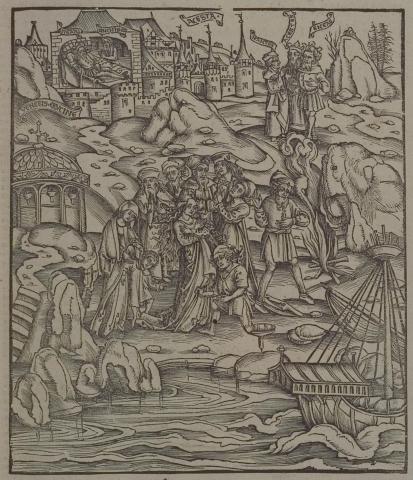Annotations
In the upper right corner, Nautes [Nantes] advises Aeneas and Acestes about how to handle the dissent among Aeneas's followers. He advises Aeneas to allow any tired old men and women who are weary of traveling to stay behind in Sicily, and found a city under the protection of Acestes (704-18). In the upper left, sleeping Aeneas receives advice from a vision of his father Anchises. Anchises agrees with Nautes, and then advises Aeneas to stop at Avernus for a journey to the underworld before heading to Latium (721-40). The city of Acesta is shown to the left of the leaders, having been marked out, and apparently built, by Aeneas before he begins his preparations to continue to Latium (755-8). In the center of the image, a few women, some old men and an injured man represent the people who will stay behind in Acesta (750-1). In the lower right, a fully repaired ship represents the Trojan fleet, which Aeneas's remaining men have repaired (752-3). On the left, at the top of Mount Eryx, here no more than a hill, a new temple to Venus has been founded, labeled here as Veneris Erucine (759-60). (Katy Purington)
Woodcut illustration from the “Strasbourg Vergil,” edited by Sebastian Brant: Publii Virgilii Maronis Opera cum quinque vulgatis commentariis expolitissimisque figuris atque imaginibus nuper per Sebastianum Brant superadditis (Strasbourg: Johannis Grieninger, 1502), fol. 248r, executed by an anonymous engraver under the direction of Brant.


Sebastian Brant (1458-1521) was a humanist scholar of many competencies. Trained in classics and law at the University of Basel, Brant later lectured in jurisprudence there and practiced law in his native city of Strasbourg. While his satirical poem Das Narrenschiff won him considerable standing as a writer, his role in the transmission of Virgil to the Renaissance was at least as important. In 1502 he and Strasbourg printer Johannes Grüninger produced a major edition of Virgil’s works, along with Donatus’ Life and the commentaries of Servius, Landino, and Calderini, with more than two hundred woodcut illustrations. (Annabel Patterson)